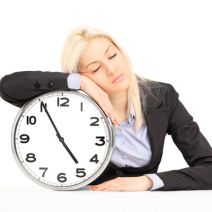Directive Blogs
Tip of the Week: Improve Productivity By Napping at Work, Seriously
 All business owners understand that in order to stay competitive, their team must work as hard as they possibly can. Unfortunately, however, that’s not how human physiology works. Everyone needs a break now and again, and the office is no different. Remember elementary school, when you would curl up with a blanket and get some sleep during naptime? It turns out this might be a viable option in the office, too.
All business owners understand that in order to stay competitive, their team must work as hard as they possibly can. Unfortunately, however, that’s not how human physiology works. Everyone needs a break now and again, and the office is no different. Remember elementary school, when you would curl up with a blanket and get some sleep during naptime? It turns out this might be a viable option in the office, too.
HubSpot, the renowned marketing company, is one of the many businesses embracing office naptime. Entrepreneur reports that HubSpot’s CMO, Mike Volpe, claims that “a 20-minute nap is often all he needs to regain focus and re-energize to be more productive for the rest of the day.” Many employees with families or younger children might not be getting enough sleep to go all-out in the office, so this extra sleep is especially helpful for them.
Wait, Napping Can Lead to More Productivity?
Napping is growing more popular in the technology industry, and when you think about it, it’s not that surprising. Many professionals work day in and day out in order to ensure that their jobs are done properly. As a business owner, you understand the need to attract top talent if you want to stay competitive; and in an evolving industry where game rooms and employee lounges were once unheard of, all of a sudden, naptime doesn’t sound so farfetched.
Even Google is embracing naptime. They take it a step further than most by integrating what they call “energy pods” into their policy. These are basically reclining chairs in a bubble that play soothing music and sounds. They even have alarm clocks so employees can get back to the daily grind after a quick catnap.
Napping Has Been Stigmatized as Lazy
Napping might seem like a great idea, but some businesses are still reluctant to integrate a corporate naptime policy. Despite the fact that research has proven that sleep is more efficient than caffeine in terms of productivity (not to mention that humans, you know, need sleep), businesses still look down on napping and label it as “irresponsible.” Napping has been stigmatized as slacking off and being lazy, which is a reputation that will be hard to kick. Terry Cralle, a certified sleep expert, argues that sleep is more imperative to a healthy lifestyle (and workplace) than an on-site gymnasium, simply because human beings need sleep in order to function at maximum efficiency.
Granted, some employers’ reservations concerning naptime are justified. For example, it’s one thing for an employee to need rest because they’re a new mother or father, but another entirely to sleep off a hangover. Proper monitoring is key to ensuring your team isn’t abusing the privilege.
How to Introduce a Naptime Policy
You might be wondering how to introduce a corporate naptime policy in a way which fosters maximum productivity. Here’s how you can take advantage of naptime in the workplace to minimize user error and keep everyone on task.
Build a specialized napping facility. We aren’t talking about making an entirely new building dedicated to sleep. Instead, transform a room into a naptime paradise. All you need is a quiet room with a comfy sofa or a hammock where your team can catch some quick z’s. Lay down a soft rug and use a calming color palette to encourage drifting off. Unfortunately for some, sleeping doesn’t come so naturally, so a place that encourages it goes a long way.
Make it known that napping is accepted in the company culture. Some employees might be nervous about indulging themselves in the occasional nap, but if you are up-front with your team about the concept, they will be more open to the idea. HubSpot’s nap room works similarly to their conference room, where it can be booked by anyone for as long and as often as they want, so long as they accomplish everything that needs to be done.
Take full advantage of naptime by encouraging strategic timing. For example, a little extra energy during a presentation might make the crowd go wild, where an exhausted team member might decrease audience participation. According to Entrepreneur, a NASA study shows that naps can provide a significant productivity boost: “a nap of just 26 minutes can boost productivity by as much as 34 percent and increase alertness by 54 percent.”
Would you consider a naptime policy for your business, or do you feel it’s too risky of a privilege to trust to your employees? Let us know in the comments.


Comments